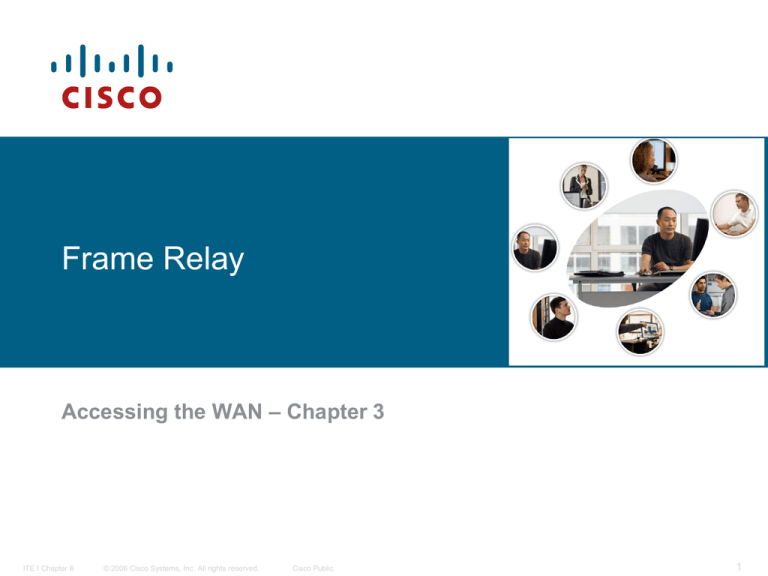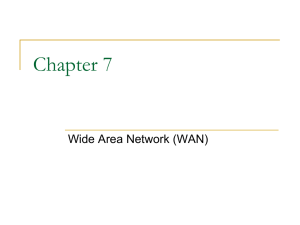
Frame Relay
Accessing the WAN – Chapter 3
ITE I Chapter 6
© 2006 Cisco Systems, Inc. All rights reserved.
Cisco Public
1
Objectives
Describe the fundamental concepts of Frame Relay technology
in terms of Enterprise WAN services including Frame Relay
operation, Frame Relay implementation requirements, Frame
Relay maps, and LMI operation.
Configure a basic Frame Relay PVC including configuring and
troubleshooting Frame Relay on a router serial interface and
configuring a static Frame Relay map.
Describe advanced concepts of Frame Relay technology in
terms of Enterprise WAN services including Frame Relay subinterfaces, Frame Relay bandwidth and flow control.
Configure an advanced Frame Relay PVC including solving
reachability issues, configuring Frame Relay sub-interfaces,
verifying and troubleshooting Frame Relay configuration.
ITE 1 Chapter 6
© 2006 Cisco Systems, Inc. All rights reserved.
Cisco Public
2
Introduction to Frame Relay
Eric Scace, an engineer at Sprint International, invented Frame Relay as a
simpler version of the X.25 protocol to use across Integrated Services
Digital Network (ISDN) interfaces.
Sprint first used StrataCom switches.
Cisco's acquisition of StrataCom in 1996 marked their entry into the carrier
market.
Network providers commonly implement Frame Relay for voice and data
as an encapsulation technique, used between LANs over a WAN.
Frame Relay has become one of the most extensively used WAN
protocols, primarily because it is inexpensive compared to dedicated lines.
ITE 1 Chapter 6
© 2006 Cisco Systems, Inc. All rights reserved.
Cisco Public
3
Conti…
Frame Relay handles volume and speed efficiently by combining the
necessary functions of the data link and Network layers into one simple
protocol.
As a data link protocol, Frame Relay provides access to a network,
delimits and delivers frames in proper order, and recognizes transmission
errors through a standard Cyclic Redundancy Check.
As a network protocol, Frame Relay provides multiple logical connections
over a single physical circuit and allows the network to route data over
those connections to its intended destinations.
ITE 1 Chapter 6
© 2006 Cisco Systems, Inc. All rights reserved.
Cisco Public
4
Frame Relay Operation
The connection between a DTE device and a DCE device consists of both
a Physical layer component and a link layer component:
The physical component defines the mechanical, electrical, functional, and
procedural specifications for the connection between the devices. One of
the most commonly used Physical layer interface specifications is the RS232 (Recommended standard-for serial binary data signals from DTE
DCE) specification.
The link layer component defines the protocol that establishes the
connection between the DTE device, such as a router, and the DCE
device, such as a switch.
POP -- Point-of-Presence (point of interconnection between the
connection facility provided by the telephone company and the building
main distribution facility)
FRAD -- Frame Relay access device
ITE 1 Chapter 6
© 2006 Cisco Systems, Inc. All rights reserved.
Cisco Public
5
Virtual Circuits
The connection through a Frame Relay network between two DTEs is
called a virtual circuit (VC). The circuits are virtual because there is no
direct electrical connection from end to end.
There are two ways to establish VCs:
SVCs, switched virtual circuits, are established dynamically by sending
signaling messages to the network (CALL SETUP, DATA TRANSFER,
IDLE, CALL TERMINATION).
PVCs, permanent virtual circuits, are preconfigured by the carrier, and
after they are set up, only operate in DATA TRANSFER and IDLE modes.
Note: Some publications refer to PVCs as private VCs.
ITE 1 Chapter 6
© 2006 Cisco Systems, Inc. All rights reserved.
Cisco Public
6
Conti…
VCs provide a bidirectional communication path from one device to
another. VCs are identified by DLCIs (data link connection identifier).
DLCI values typically are assigned by the Frame Relay service provider.
Usually, DLCIs 0 to 15 and 1008 to 1023 are reserved for special
purposes. Therefore, service providers typically assign DLCIs in the range
of 16 to 1007.
Frame Relay DLCIs have local significance, which means that the values
themselves are not unique in the Frame Relay WAN.
ITE 1 Chapter 6
© 2006 Cisco Systems, Inc. All rights reserved.
Cisco Public
7
Conti…
Multiple VCs
Frame Relay is statistically multiplexed, meaning that it transmits only one
frame at a time, but that many logical connections can co-exist on a single
physical line.
The Frame Relay Access Device (FRAD) or router connected to the
Frame Relay network may have multiple VCs connecting it to various
endpoints.
Multiple VCs on a single physical line are distinguished because each VC
has its own DLCI.
This capability often reduces the equipment and network complexity
required to connect multiple devices, making it a very cost-effective
replacement for a mesh of access lines
ITE 1 Chapter 6
© 2006 Cisco Systems, Inc. All rights reserved.
Cisco Public
8
Conti…
Frame Relay uses virtual circuits to carry packets from
one DTE to another
ITE 1 Chapter 6
© 2006 Cisco Systems, Inc. All rights reserved.
Cisco Public
9
Standard Frame Relay Frame
Frame Relay takes data packets from a Network layer protocol, such as IP
or IPX, encapsulates them as the data portion of a Frame Relay frame,
and then passes the frame to the Physical layer for delivery on the wire.
The header and trailer are defined by the Link Access Procedure for
Frame Relay (LAPF) Bearer Services specification, ITU Q.922-A.
DLCI
Extended Address ( value=1 mean last DLCI)
C/R (not generally used by Frame Relay)
Congestion Control Contains 3 bits : FECN ( Forward Explicit Congestion Notification)
BECN ( Backward Explicit Congestion Notification)
DE
ITE 1 Chapter 6
( Discard Eligible)
© 2006 Cisco Systems, Inc. All rights reserved.
Cisco Public
10
Frame Relay Topology
You need to consider the topology from several perspectives to
understand the network and the equipment used to build the network.
Complete topologies for design, implementation, operation, and
maintenance
Star ( Hub and Spoke) Topology :The simplest WAN topology is a star,
Full Mesh: A full mesh topology suits a situation in which the services
to be accessed are geographically dispersed and highly reliable access to
them is required.
ITE 1 Chapter 6
© 2006 Cisco Systems, Inc. All rights reserved.
Cisco Public
11
Conti…
Partial Mesh Topology
For large networks, a full mesh topology is seldom affordable because the
number of links required increases dramatically.
The issue is not with the cost of the hardware, but because there is a
theoretical limit of less than 1,000 VCs per link. In practice, the limit is less
than that.
For this reason, larger networks are generally configured in a partial mesh
topology.
ITE 1 Chapter 6
© 2006 Cisco Systems, Inc. All rights reserved.
Cisco Public
12
Conti…
Types of topologies that are used for implementing
Frame Relay in different environments
ITE 1 Chapter 6
© 2006 Cisco Systems, Inc. All rights reserved.
Cisco Public
13
Local Management Interface (LMI)
Need for DTEs to dynamically acquire information about the status of the
network.
A consortium of Cisco, Digital Equipment Corporation (DEC), Northern
Telecom, and StrataCom extended the Frame Relay protocol to provide
additional capabilities for complex internetworking environments. These
extensions are referred to collectively as the LMI.
Basically, the LMI is a keepalive mechanism that provides status
information about Frame Relay connections between the router (DTE) and
the Frame Relay switch (DCE). R1#show frame-relay lmi
ITE 1 Chapter 6
© 2006 Cisco Systems, Inc. All rights reserved.
Cisco Public
14
Conti….
The LMI type configured on the router must match the type used by the
service provider.
If it is necessary to set the LMI type, use the frame-relay lmi-type [cisco
| ansi | q933a] interface configuration command.
Configuring the LMI type, disables the autosense feature.
When manually setting up the LMI type, you must configure the keepalive
interval on the Frame Relay interface to prevent status exchanges
between the router and the switch from timing out.
You can change the keepalive interval with the keepalive interface
configuration command. Default is 10s.
ITE 1 Chapter 6
© 2006 Cisco Systems, Inc. All rights reserved.
Cisco Public
15
Configure a Basic Frame Relay PVC
Configure a static Frame Relay map (static)
ITE 1 Chapter 6
© 2006 Cisco Systems, Inc. All rights reserved.
Cisco Public
16
Frame Relay Configuration
Step 1. Setting the IP Address on the Interface – ip address command
Step 2. Configuring Encapsulation – encapsulatin frame-relay [cisco |
ietf ] command
Step 3. Setting the Bandwidth – bandwidth command
Step 4. Setting the LMI Type (optional)
Subinterface configuration (dynamic)
R1(config-if)#interface serial 0/0/0.103 point-to-point.
R1(config-subif)#frame-relay interface-dlci 103.
Configuring a Static Frame Relay Map
frame-relay map protocol protocol-address dlci [broadcast]
To Verify
Show frame-relay map
ITE 1 Chapter 6
© 2006 Cisco Systems, Inc. All rights reserved.
Cisco Public
17
Configure an Advanced Frame Relay PVC
Steps to configure point-to-point subinterfaces on a
physical interface (dynamic)
ITE 1 Chapter 6
© 2006 Cisco Systems, Inc. All rights reserved.
Cisco Public
18
Advanced Concepts of Frame Relay
Technology
The reachability issues associated with the Frame
Relay NBMA topology
ITE 1 Chapter 6
© 2006 Cisco Systems, Inc. All rights reserved.
Cisco Public
19
Solving Reachability issue
Frame Relay Subinterfaces
Frame Relay can partition a physical interface into multiple virtual
interfaces called subinterfaces.
A subinterface is simply a logical interface that is directly associated with a
physical interface.
Therefore, a Frame Relay subinterface can be configured for each of the
PVCs coming into a physical serial interface.
Frame Relay subinterfaces can be configured in either point-to-point or
multipoint mode:
Point-to-point A single point-to-point subinterface establishes one PVC
connection to another physical interface or subinterface on a remote
router on its own subnet,
Multipoint A single multipoint subinterface establishes multiple PVC
connections to multiple physical interfaces or subinterfaces on remote
routers in the same subnet.
ITE 1 Chapter 6
© 2006 Cisco Systems, Inc. All rights reserved.
Cisco Public
20
Paying for Frame Relay
Key Terminologies
Access rate or port speed
From a customer's point of view, the service provider provides a serial
connection or access link to the Frame Relay network over a leased line.
The speed of the line is the access speed or port speed.
Committed Information Rate (CIR)
Customers negotiate CIRs with service providers for each PVC. The CIR
is the amount of data that the network receives from the access circuit.
Oversubscription
Service providers sometimes sell more capacity than they have This can
cause traffic issues, such as congestion and dropped traffic.
ITE 1 Chapter 6
© 2006 Cisco Systems, Inc. All rights reserved.
Cisco Public
21
Conti…
Burst
A great advantage of Frame Relay is that any network capacity that is
being unused is made available or shared with all customers, usually at no
extra charge.
Bursting allows devices that temporarily need additional bandwidth to
borrow it at no extra cost from other devices not using it.
Various terms are used to describe burst rates including the Committed
Burst Information Rate (CBIR) and Excess Burst (BE) size.
ITE 1 Chapter 6
© 2006 Cisco Systems, Inc. All rights reserved.
Cisco Public
22
Configure an Advanced Frame Relay PVC
Commands used for verifying Frame Relay operation
Show frame-relay pvc 102, show frame-relay map|lmi,
clear frame-relay inarp
ITE 1 Chapter 6
© 2006 Cisco Systems, Inc. All rights reserved.
Cisco Public
23
Configure an Advanced Frame Relay PVC
Steps for troubleshooting a Frame Relay configuration
ITE 1 Chapter 6
© 2006 Cisco Systems, Inc. All rights reserved.
Cisco Public
24
Summary
Frame relay is the most widely used WAN technology
because it:
–Provides greater bandwidth than leased line
–Reduces cost because it uses less equipment
–Easy to implement
Frame relay is associated with layer 2 of the OSI model
and encapsulates data packets in a frame relay frame
Frame relay is configured on virtual circuits
–These virtual circuits may be identified by a DLCI
Frame relay uses inverse ARP to map DLCI to IP
addresses
ITE 1 Chapter 6
© 2006 Cisco Systems, Inc. All rights reserved.
Cisco Public
25
Summary
Configuring frame relay requires
–Enable frame relay encapsulation
–Configuring either static or dynamic mapping
–Considering split horizon problems that develop when multiple
VCs are placed on a single physical interface
Factor affecting frame relay configuration
–How service provider has their charging scheme set up
Frame relay flow control
–DE
–FECN
–BECN
ITE 1 Chapter 6
© 2006 Cisco Systems, Inc. All rights reserved.
Cisco Public
26
Summary
The following commands can be used to help verify
frame relay configuration
–Show interfaces
–Show frame-relay lmi
–Show frame-relay pvc ###
–Show frame-relay map
Use the following command to help troubleshoot a
frame relay configuration
–Debug frame-relay lmi
ITE 1 Chapter 6
© 2006 Cisco Systems, Inc. All rights reserved.
Cisco Public
27
ITE 1 Chapter 6
© 2006 Cisco Systems, Inc. All rights reserved.
Cisco Public
28








